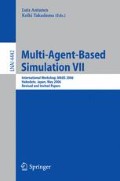Abstract
This paper discusses dynamic properties of peer-to-peer communication networks, which emerge from information exchanges among people. First, we gather activity data of communication among people through questionnaires in order to categorize both information (contents) and people, then we develop agent-based simulation models to examine implicit mechanisms behind the dynamics. The agent-based models enable us to discover the quality of information exchanged and the preferences of specific communication groups. The simulation results have suggested that 1) peer-to-peer communication networks have scale-free and small world properties, 2) the characteristics of contents and users are observed in word-of-mouth communications, and 3) the combination of real survey data and agent-based simulation is effective.
Access this chapter
Tax calculation will be finalised at checkout
Purchases are for personal use only
Preview
Unable to display preview. Download preview PDF.
References
Rosen, E.: The Anatomy of Buzz: How to Create Word of Mouth Marketing. Doubleday (2002)
Kokokusha: Survey for the word of mouth (In Japanese) (2005), http://www.kokokusha.co.jp/service/kuchikomi.html
Ebel, H., et al.: Dynamics of Social Networks. Complexity 8(2), 24–27 (2003)
Scott, J.: Social Network Analysis. Sage Publications, Thousand Oaks (2000)
Barabasi, A-L.: Linked: The New Science of Networks. Perseus Books Group (2002)
Watts, D.J.: Small Worlds: The Dynamics of Networks Between Order and Randomness (Princeton Studies in Complexity). Princeton Univ. Pr., Princeton (2004)
Newman, M.E.J.: The Structure and Function of Complex Networks. SIAM REVIEW 2003 Society for Industrial and Applied Mathematics 45(2), 167–256 (2003)
Terano, T., Deguchi, H., Takadama, K.: Meeting the Challenge of Social Problems via Agent-Based Simulation. Springer, Heidelberg (2003)
Gilbert, N.: Agent-based social simulation: dealing with complexity. The Complex Systems Network of Excellence (2004)
Bonabeau, E.: Agent-based modeling: Methods and techniques for simulating human systems. PNAS 99(suppl 3), 7280–7287 (2002)
Matsuyama, S., Kunigami, M., Terano, T.: Multi-Agent Modeling of Peer to Peer Communication with Scale-Free and Small-World Properties. In: Khosla, R., Howlett, R.J., Jain, L.C. (eds.) KES 2005. LNCS (LNAI), vol. 3684, pp. 772–778. Springer, Heidelberg (2005)
Barabasi, A.L., Albert, R., Jeong, H.: Mean-field theory for scale-free random networks. Physica A 272, 173–187 (1999)
Dorogovtsev, S.N., Mendes, J.F.F.: Scaling behaviour of developing and decaying networks. Europhys. Lett. 52, 33–39 (2000)
Holme, P.: Edge overload breakdown in evolving networks. Phys. Rev. E 66 art. no.036119 (2002)
Author information
Authors and Affiliations
Editor information
Rights and permissions
Copyright information
© 2007 Springer-Verlag Berlin Heidelberg
About this paper
Cite this paper
Matsuyama, S., Terano, T. (2007). Analyzing Dynamics of Peer-to-Peer Communication -From Questionnaire Surveys to Agent-Based Simulation. In: Antunes, L., Takadama, K. (eds) Multi-Agent-Based Simulation VII. MABS 2006. Lecture Notes in Computer Science(), vol 4442. Springer, Berlin, Heidelberg. https://doi.org/10.1007/978-3-540-76539-4_3
Download citation
DOI: https://doi.org/10.1007/978-3-540-76539-4_3
Publisher Name: Springer, Berlin, Heidelberg
Print ISBN: 978-3-540-76536-3
Online ISBN: 978-3-540-76539-4
eBook Packages: Computer ScienceComputer Science (R0)

